Quatuor Mosaïques (2005)
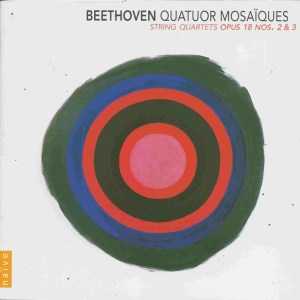
Beethoven: String Quartets op.18/2 & 18/3
naïve E 8902 (stereo); ℗ 2006 / 2007
![]()
This is the second CD of Beethoven’s op.18 with Erich Höbarth, Andrea Bischof, Anita Mitterer, and Christophe Coin, covering op.18/2 and op.18/3, recorded in 2005. For general comments .
1. Allegro (2/4)
8’12”; 1/4 = 82This sounds like an andante rather than an allegro — in compensation, one gets rewarded with a lot of attention to details, phrasing, transparency, making it easy to follow the polyphony in this movement!
2. Adagio cantabile (3/4) — Allegro (2/4) — Tempo I
5’41”; 1/8 = 72 — 1/4 = 112Same base pace as the Guarneri Quartet, but as they play without the excess ritardandi, this feels much more fluent, and ornaments are played as such, the (slow, extended) melodies can be followed, and a lot of clarity is gained by restricting the vibrato to a minimum (it really is an ornament here!). Very nice articulation in the allegro showing details that can’t be heard elsewhere — very nice!
3. Scherzo: Allegro (3/4) — Trio (3/4)
4’36”; 1/4 = 140This is truly allegro, not presto! This may be the slowest version — but that’s more than compensated by a much larger dynamic range (like these ff outbursts!), transparency, so much more detail!!
4. Allegro molto quasi Presto (2/4)
5’32”; 1/4 = 168This is more moderate than the Melos Quartett in the tempo — which gives these artists the opportunity for playful, dynamic and more colorful playing, extra freedom in the agogics, transparency, a lot more detail (polyphonic parts!); I also like the two short cadenzas at fermata points — they sound so natural that one starts wondering why none of the others use this opportunity!
| Recommendation: | Yet again, my clear favorite! I love the sound of these instruments — I think the playing without (or with little) vibrato exhibits the real qualities of these period instruments! |
| Rating: | 5.0 (5 / 5 / 5 / 5) |
String Quartet No. 6 (B-dur), op. 18, No. 6
Композитор
Людвиг ван Бетховен
Год создания
1800
Жанр
камерные и инструментальные
Страна
Германия
Бетховенский квартет № 6 по нумерации является последним в ор. 18, но, возможно, пятым по времени написания.
Первая часть (Allegro con brio, alla breve, половинная по метроному = 80) начинается главной партией — бодрой, живой, с оттенком юмора. Тема побочной партии широкая, певучая. Короткая заключительная партия, основанная на теме главной партии, приводит к энергичному, решительному окончанию экспозиции. Что касается разработки, то она довольно традиционна. Реприза является точным повторением экспозиции. Кода отсутствует.
Большой любовью у слушателей пользуется вторая часть (Adagio ma non troppo, 2/4, шестнадцатая = 80). Это спокойная, пленительная музыка, развивающаяся в лирическом плане (см. пример 30).
Выразительна тема в Es-dur, начинающаяся унисоном скрипки и виолончели (пример 31).
В репризе сложной трехчастной формы темы варьируются.
Третья часть — скерцо (Allegro, 3/4, половинная с точкой = 63), подобно первой части квартета, проникнута веселым и беззаботным настроением, которое постепенно переходит в безудержное ликование. Частые синкопы придают скерцо шутливый характер.
Перлом квартета B-dur является его финал — знаменитая «La Malinconia» («Меланхолия»); в ней Бетховен поразительно передает тончайшие душевные переживания, употребляя самые простые средства. Эта часть (Adagio, 3/8, четверть с точкой = 88) сопровождается в начале такой надписью: «Questo pezzo si deve trattore colla piu delicatezza» («Эту пьесу следует исполнять в высшей степени деликатно»). Первое появление темы звучит в высоком регистре pianissimo и излагается скрипками и альтом без участия виолончели (пример 32).
Повторение первого четырехтакта в более низком регистре придает теме мрачное звучание. Затем та же тема модулирует в h-moll, при этом образуется цепочка из четырех уменьшенных септаккордов (см. пример 33).
Однако меланхолия не к лицу юности, для которой открыт весь мир с его радостями и надеждами, а потому отбросим все мрачное и будем резвиться и танцевать! И вот во исполнение этого призыва после последнего глубокого вздоха Бетховен неожиданно переключает слушателей в шутливо-веселую часть (Allegretto quasi allegro, 3/8, четверть с точкой = 48) танцевального характера (пример 34).
С этой беззаботной веселостью меланхолия не может бороться и проявляет себя только в двух коротких вставках Adagio. Далее до Росо Adagio все звучит игриво и шутливо.
В Росо Adagio снова слышится раздумье. Композитор как бы задает вопрос: имеем ли мы право веселиться? На это следует утвердительный ответ; наступает prestissimo (3/8, четверть с точкой = 112), подобное бурному танцу. Таким образом, в финале происходит борьба двух настроений: мрачной меланхолии и самого безудержного веселья, причем победа остается за последним. Форма этой части — рондо-соната со вступлением в медленном темпе — унаследована Бетховеном от Люлли; ею пользовался также Гайдн в своих симфониях.
Продолжительность исполнения квартета 22 минуты: I ч. — 7 мин., II ч.— 5 мин., III ч. — 4 мин., IV ч. — 6 мин.
П. Долгов
- Струнные квартеты, Op. 18 →
- Струнные квартеты Бетховена →
Endellion String Quartet (2008)
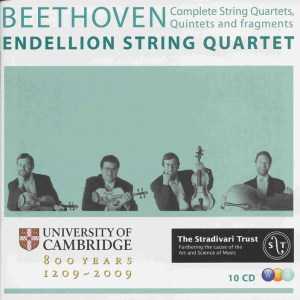
Beethoven: Complete String Quartets, Quintets & Fragments
WCJ (Warner Classics & Jazz) 2564 69471-3 (stereo, 10 CD); ℗ / 2008
![]()
Recorded in 2008, with Andrew Watkinson, Ralph de Souza, Garfield Jackson, David Waterman — for general remarks see .
1. Allegro (2/4)
8’05”; 1/4 = 80Pretty slow and “leaned back”, Andante rather than Allegro — but otherwise OK, even good, the best movement I heard of the Endellion String Quartet so far (looks like this movement is a better “fit” for this ensemble than the virtuosic ones in ): well articulated, good phrasing. A nice detail: the parallel octaves between the two violins in the recapitulation part, played with very little (if any) vibrato and clear intonation.
2. Adagio cantabile (3/4) — Allegro (2/4) — Tempo I
5’54”; 1/8 = 64 — 1/4 = 142I don’t know why they select such fuzzy, soft articulation in the Adagio cantabile part — this (combined with a vibrato that is spread over the entire section) doesn’t make this more expressive — quite to the contrary! Also, for my feeling, the intonation is a bit marginal at times, in the Adagio cantabile. Worse than that: the Allegro part is played too fast, with an articulation that can be called superficial — at best!
3. Scherzo: Allegro (3/4) — Trio (3/4)
4’19”; 1/4 = 160OK, but the tempo is at the upper limit for this ensemble: articulation is just still possible, though one starts feeling “pushed”; the Trio is OK.
4. Allegro molto quasi Presto (2/4)
5’35”; 1/4 = 160Some rushed passages / figures, occasionally, (to my ear) the intonation is marginal. On the bright side, besides the Quatuor Mosaïques they are the only ones adding a cadenza in this movement.
| Recommendation: | OK, but not more, except for the first movement, maybe. |
| Rating: | 3.0 (4 / 2 / 3 / 3) |
The Composition
The String Quartet in G major, op.18/2 by Ludwig van Beethoven (1770 – 1827) features the following movements:
1. Allegro (2/4)
In the opening movement, Beethoven specifies “Allegro” (lively, not fast!) — the movement is written in 2/4 time, but if the quarter notes are really played allegro (typically 1/4 = 90, if not more), the fast ornaments are hardly playable. If on the other hand the tempo is adjusted for the ornaments, the tempo typically feels like allegretto at most, if not andante — tricky!

2. Adagio cantabile (3/4) — Allegro (2/4) — Tempo I
The second movement presents challenges in the tempo, too: Beethoven writes Adagio cantabile, where adagio means calm, not slow; the movement is written in 3/4 time — however, most of the notation rather looks like 6/8 (2 groups of 3 eighths) — the artists play 1/8 = 60 up to 72 (which really would be 1/4 = 30 up to 36 — but the quarter beat can’t really be played anyway). I think this is one instance where one should focus on the cantabile while maintaining a calm character for the slow parts.

Then, there’s the question of the Allegro part: should there be a relationship between the main beats (1/4) and a beat in the adagio part? Some ensembles indeed play 1/4 at twice the speed as the eighths in the adagio, i.e., 2/4 (entire bar in the allegro) at the pace of 1/8 in the adagio. This is not prescribed by Beethoven, but some may call this obvious. The allegro part has its own challenges, in that the 1/16 (down) + 3/16 (up) are hard to play at this pace!

Timing Comparison
As one of the few things that one can actually “measure” in music performances, I’m giving the approximate metronome numbers for each of the movements in the text below. As these numbers are spread over the text, I felt it would help if I collected them in a table, shown below. I have used color coding to indicate relative rates: white would be the average tempo, blue fields are slower tempi, green indicates faster-than-average performances (where the strength of the color indicates the amount of deviation from the average). Some ensembles prefer slower tempi, others are faster throughout, some are “mixed bags” (click on table for full size view):

Timing Comparison
As one of the few things that one can actually “measure” in music performances, I’m giving the approximate metronome numbers for each of the movements in the text below. As these numbers are spread over the text, I felt it would help if I collected them in a table, shown below. I have used color coding to indicate relative rates: white would be the average tempo, blue fields are slower tempi, green indicates faster-than-average performances (where the strength of the color indicates the amount of deviation from the average). Some ensembles prefer slower tempi, others are faster throughout, some are “mixed bags” (click on table for full size view):

Melos Quartett Stuttgart (1983)
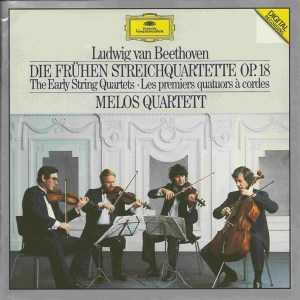
Beethoven: Die frühen Streichquartette op.18
DG 410 971-2 (stereo, 3 CD); ℗ 1984
![]()
Recorded in 1983, with Wilhelm Melcher, Gerhard Voss, Hermann Voss, Peter Buck — for general comments and CD information ;
1. Allegro (2/4)
6’59”; 1/4 = 92This is the fastest version, but comes closest to an allegro in character — the payoff is that there is less differentiation / attention for the detail than with the Artemis Quartet.
2. Adagio cantabile (3/4) — Allegro (2/4) — Tempo I
6’35”; 1/8 = 64 — 1/4 = 138The adagio part is rather free (senza tempo, almost), the cantabile very expressive (the vibrato is a bit too heavy, though). The articulation in the allegro is excellent! Unfortunately, the Adagio cantabile is dominated by a vast excess of vibrato.
3. Scherzo: Allegro (3/4) — Trio (3/4)
4’01”; 1/4 = 168Rather Presto than Allegro — but very well played, playful, expressive, scherzoso; playful also in the Trio part. Lots of character, never stiff, but flexible, yet very clean and characterful; I like the outbursts in this movement!
4. Allegro molto quasi Presto (2/4)
5’07”; 1/4 = 178This is probably at the upper speed limit — but absolutely mastered by the Melos Quartett; they also always keep the control over the tempo and the dynamics — excellent!
| Recommendation: | For me, clearly the second recommendation (maybe the first recommendation for those who dislike non-vibrato playing!) |
| Rating: | 4.2 (4 / 3 / 5 / 5) |
The Composition
The String Quartet in D major, op.18/3 by Ludwig van Beethoven (1770 – 1827) features the following movements:
1. Allegro (alla breve, 2/2)
The beginning of this movement (shown here) may be somewhat misleading: it looks like — and is — a slow introduction, but not necessarily the way one might think: some ensembles start the movement with a slower tempo, reaching the intended allegro only around bar #20. This forces the artists to switch back to the slower pace when they return to the beginning of the exposition, thereby disrupting the flow — plus, the “intro theme” returns at various places in the movement, and then one can’t always slow down.

Also, one should note that no indication for such tempo changes are found in the score. I believe that the “slow” is there — but implicitly, as part of the composition, i.e., through the initial, long chords the impression of a slow introduction is there even if a (more or less) constant tempo is used throughout.
2. Andante con moto (2/4)
Another “notation mystery” here: Andante con moto, 2/4 — but all ensembles here clearly read this as Andante con moto on the eights (i.e., played like 4/8), not on the quarter notes (even though the major beats are of course on the quarter notes). Then, there’s the character of the piece — is it really just a lovely andante, or isn’t there more behind this? After all, Beethoven often puts a lot of his emotions into his slow movements — read on!

3. Allegro (3/4)
The tempo is an issue also in this movement (looks like a quartet full of tempo mysteries!): most quartets play entire bars rather than three quarter notes; this leads to a fast tempo that tends to suppress the details in the minore part with its sixteenth passages. Another interesting feature is in the many octave parallels, especially between the two violins, in this movement — see the notes on the Quatuor Mosaïques. The real question is whether this is merely a harmless, playful Menuet-style dance, or rather a more serious and dramatic piece of music; the Quatuor Mosaïques answers this rather convincingly, I think!


4. Presto (6/8)
A bit unusual, this is another sonata movement, with the exposition to be repeated. The tempo is supposed to be presto, the notation is 6/8 – to be played 3 + 3. The eights are the smallest notes (if we disregard the few notes with appoggiatura), making it tempting to play this very fast — at the expense of details, articulation and phrasing; especially the oddly placed sforzati suggest a slower tempo, as shown by the Quatuor Mosaïques.

Emerson String Quartet (1996)
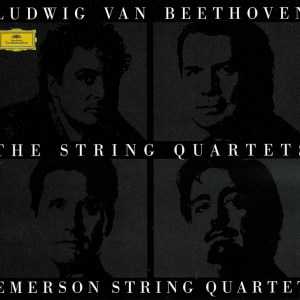
Beethoven: The String Quartets (opp. 18, 59, 74, 95, 127, 130-133, 135)
DG 447 075-2 (stereo, 7 CD); ℗ 1996
![]()
Recorded in 1996, with Eugene Drucker, Philip Setzer, Lawrence Dutton, David Finckel — for general comments and CD information
2. Adagio cantabile (3/4) — Allegro (2/4) — Tempo I
5’54”; 1/8 = 70 — 1/4 = 140Too much vibrato. The tempo is rather linear — but too slow, really: the ornaments are played as melody, hereby stretching out the real melody beyond recognition. Beat taken over for the allegro part (see above), though the sixteenth notes are somewhat hasted, not very clear (they are a challenge, though!)
3. Scherzo: Allegro (3/4) — Trio (3/4)
4’04”; 1/4 = 162Good (no more, no less) — either this movement is better suited for these artists, or the music is simply stronger??
4. Allegro molto quasi Presto (2/4)
5’10”; 1/4 = 172Very fast, but well played — though at times one feels somewhat chased, pressed for speed.
| Recommendation: | The Emerson quartet is much better here than in op.18/1 — is the music a better fit for these artists, or is Beethoven’s music simply stronger here, such that their sterile playing can’t prevail? |
| Rating: | 3.5 (3 / 3 / 4 / 4) |
The Composition
The String Quartet in C minor, op.18/4 by Ludwig van Beethoven (1770 – 1828) features the following movements:
1. Allegro ma non tanto (4/4)
This is one of several key works by Beethoven written in C minor:
- the piano trio op.1/3
- the opening movement of the piano sonata op.10/1
- the piano sonata op.13 “Pathétique”
- the opening and the last movement in the sonata for piano & violin op.30/2
- the opening movement of the third piano concerto op.37
- the symphony nr.5 op.67
- the piano introduction to the choral fantasy op.80
- the opening movement to the last piano sonata, op.111
- the 32 variations on an original theme WoO 80
From these works one can see that C minor for Beethoven was the tonality to express strong emotions, internal turmoil, if not drama — and this certainly also applies to this and other movements in this quartet.

2. Scherzo: Andante scherzoso quasi Allegretto (3/8)
One interesting feature in this quartet is that there is no really slow movement — and that there is both a Menuetto and a Scherzo. The most striking feature in this movement are the many fugati or canon-like segments, meaning that focus here is on polyphony and transparency — a strongly leading first violin does not help, to say the least! Secondly, there are long sequences of eighth and sixteenth notes with staccato notation. From some of the older recordings one can gather that it must be quite tough to play these staccato notes short & fast, but still so that they are more than scratching noise!

3. Menuetto: Allegretto (3/4) — Trio (3/4) — Menuetto da capo
Tempo relations are an interesting topic with this movement: The main tempo is allegretto, presumably something between an andante (“walking”) and an allegro (“joyful”, not fast!). There is no tempo annotation with the Trio, and both parts are in 3/4 measures, but at the end of the Trio, Beethoven writes Menuetto da capo, and La seconda volta si prende il Tempo più Allegro: the second pass of the Menuetto should be played faster (than the first one); whether that means prestissimo is another question!

The Trio has two tricky moments for the first violin: in the first part there is a sfp fermata on the a”’, and after a general break, the melody continues solo, p, and on a” (an octave lower); in the second half, the same passage is even a fifth higher, on d”” / d”’: with the older recordings the beginning after the break is often shaky, some even have problems with the intonation during the rapid diminuendo in the sfp.

4. Allegro (alla breve, 2/2) — Prestissimo
A dramatic Rondo of sorts, with the intermezzi opening up an entire microcosmos, particularly in certain interpretations! Some highly exposed, “touchy” passages for the first violin!


Amadeus Quartet (1961)
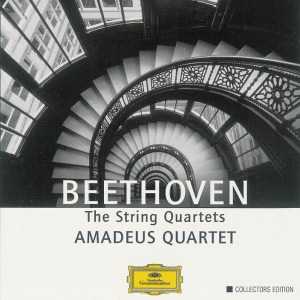
Beethoven: The String Quartets (opp. 18, 59, 74, 95, 127, 130-133, 135)
DG 463 143-2 (stereo, 7 CD); ℗ 1962 / 1974
![]()
Recorded in 1961, with Norbert Brainin, Siegmund Nissel, Peter Schidlof, Martin Lovett — for general comments and CD information
1. Allegro (2/4)
5’45” (exposition not repeated); 1/4 = 88The basic speed is among the faster ones for this movement — yet the character is allegretto at best. The tone is fairly rough, often almost violent, some of the ornaments aren’t played very carefully. A mystery why they don’t repeat the exposition!
2. Adagio cantabile (3/4) — Allegro (2/4) — Tempo I
6’20”; 1/8 = 68 — 1/4 = 126The vibrato of the first violin is almost unbearable, almost obnoxious: very slow, heavy, too strong. On top of that, some portamenti make this sound like a really old interpretation. The allegro is dominated by their rough tone and excess accents on the first note in every bar.
3. Scherzo: Allegro (3/4) — Trio (3/4)
4’19”; 1/4 = 150Fast notes are rushed over, not carefully played, the accents are hard, if not harsh, the Trio is somewhat stiff.
4. Allegro molto quasi Presto (2/4)
5’46”; 1/4 = 156Rough, coarse, loud — often, the melody voice covers all others. Also, there is a slight tendency to associate crescendo with accelerando, for no obvious reason (often considered a bad habit!)
| Recommendation: | no! |
| Rating: | 2.0 (2 / 2 / 2 / 2) |
Artemis Quartet (2002)

Beethoven: String Quartets opp. 18/2, 59/3, 131, 132
Virgin Classics 50999 607102 0 8 (2 CD, stereo); ℗ 2000-2003 / 2010
![]()
Recorded in 2002, with Natalia Prischepenko, Heime Müller, Volker Jacobsen, and Eckart Runge, as part of their set of the complete Beethoven quartet recordings. This one is still with their original composition with Heime Müller and Sigi Feigl who have since left the quartet. If I’m not mistaken, they used more vibrato in 2002 than they do now!
1. Allegro (2/4)
7’43”; 1/4 = 86For me, the character of the movement remains a bit on the slow side (rather allegretto than allegro, from the base beat) — however, they have an enormous width in expression (what a contrast to the Emerson Quartet!), all details are well played out and clear.
3. Scherzo: Allegro (3/4) — Trio (3/4)
5’09” (da capo part with repetitions); 1/4 = 152Clean playing, though with less character and expression than the Melos Quartett. The Trio is played with its own character, a tad slower than the first part.
4. Allegro molto quasi Presto (2/4)
5’17”; 1/4 = 182Too fast? The staccato eighths sometimes appear to run away. Slower and more carefully would have been better!
| Recommendation: | Good — though I think it does not reach or match the qualities of op.18/1 — the difference could be due to the new quartet composition, or maybe simply through the additional experience over the past years? |
| Rating: | 4.2 (5 / 4 / 4 / 4) |
The Composition
The String Quartet in B♭ major, op.18/6 by Ludwig van Beethoven (1770 – 1827) features the following movements:
1. Allegro con brio (alla breve, 2/2)
This is a sonata movement with alla breve notation — however, it is clearly impossible to play two beats per bar as a true allegro con brio (which would imply something like 1/2 = 100 – 120). Only the Artemis Quartet follows the repetition marks around the evolution / recapitulation part, see below.

2. Adagio ma non troppo (2/4)
An adagio based on 1/4 beats would hardly be playable, with all the ornaments in this movement, the tempo in use here is between 1/8=42 and 1/8=49.

3. Scherzo: Allegro (3/4) — Trio (3/4)
A typical Beethoven Scherzo, with lots of “syncope jokes”, making it hard for the unexperienced listener to follow the beat!


4. La Malinconia: Adagio (2/4) — Allegretto quasi Allegro (3/8)
This movement bears an interesting instruction by Beethoven: “Questo pezzo si deve trattare colla più gran delicatezza” — to be played with the greatest possible care / refinement; and then, there is a title “La Malinconia” — the melancholy. Some ensembles seem to assume that this applies to the slow initial part only, making the 3/8 Allegretto quasi Allegro sound almost like a fast dance movement. They take the slow part (and “malinconia”) for “depressive”, and the “dance” part for “raving” — I’m not sure it’s that simple, as the “depressive” part returns for two short intermezzi in the Allegretto quasi Allegro part, and that Allegretto is not entirely joyful (except maybe for the last few prestissimo bars), see the interpretation by the Quatuor Mosaïques!


Timing Comparison
As one of the few things that one can actually “measure” in music performances, I’m giving the approximate metronome numbers for each of the movements in the text below. As these numbers are spread over the text, I felt it would help if I collected them in a table, shown below. I have used color coding to indicate relative rates: white would be the average tempo, blue fields are slower tempi, green indicates faster-than-average performances (where the strength of the color indicates the amount of deviation from the average). Some ensembles prefer slower tempi, others are faster throughout, some are “mixed bags” (click on table for full size view):

Quartetto Italiano (1975)
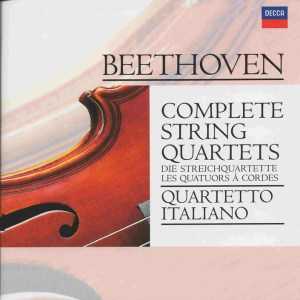
Beethoven: Complete String Quartets (opp. 18, 59, 74, 95, 127, 130-133, 135)
Decca 454 062-2 (stereo, 10 CD); ℗ 1972 / 1996
![]()
Recorded in 1975, with Paolo Borciani, Elisa Pegreffi, Piero Farulli, Franco Rossi — for general comments and CD information .
1. Allegro (2/4)
8’29”; 1/4 = 76This is on the slow and heavy side — for me, this rather sounds like an andante; they probably followed the philosophy of adjusting the tempo such that the smaller notes remain well playable, disregarding the rest?
2. Adagio cantabile (3/4) — Allegro (2/4) — Tempo I
6’44”; 1/8 = 60 — 1/4 = 130This definitely is slow, not just calm — too slow, in my opinion. Plus, the first violin uses a very heavy vibrato, which makes the adagio part very heavy. They close the first part with an extensive ritardando / smorzando — there is no attempt to link the fast part with the adagio.
4. Allegro molto quasi Presto (2/4)
5’56”; 1/4 = 152OK, no more, no less
| Recommendation: | An OK interpretation for those who prefer the “traditional” approach — though I can’t really recommend it (unless you are a fan of this ensemble). |
| Rating: | 2.5 (2 / 2 / 3 / 3) |
Guarneri String Quartet (1995)

Beethoven: String Quartets op.18
Philips 434 115-2 (stereo, 3 CD); ℗ / 1995
![]()
Recorded in 1995, with Arnold Steinhardt, John Dalley, Michael Tree, David Soyer — for general comments and CD information
2. Adagio cantabile (3/4) — Allegro (2/4) — Tempo I
5’39”; 1/8 = 72 — 1/4 = 145Adagio: pretty heavy vibrato, extreme agogics — almost senza tempo. They take over the beat of the allegro from the adagio part — however, unfortunately, the fast notes in the allegro aren’t played very carefully.
3. Scherzo: Allegro (3/4) — Trio (3/4)
4’09”; 1/4 = 158There are some slight accelerandi that I don’t quite understand — cutting artifacts, or intentional? The Trio is OK.
4. Allegro molto quasi Presto (2/4)
5’39”; 1/4 = 160Often, the tempo in rapid sixteenth passages, or in staccato eighths appears rushed, careless (loss of control?)
| Recommendation: | An OK interpretation for those who prefer the “traditional” approach — though I can’t really recommend it for any good reason. |
| Rating: | 2.5 (3 / 2 / 3 / 2) |
Timing Comparison
As one of the few things that one can actually “measure” in music performances, I’m giving the approximate metronome numbers for each of the movements in the text below. As these numbers are spread over the text, I felt it would help if I collected them in a table, shown below. I have used color coding to indicate relative rates: white would be the average tempo, blue fields are slower tempi, green indicates faster-than-average performances (where the strength of the color indicates the amount of deviation from the average). Some ensembles prefer slower tempi, others are faster throughout, some are “mixed bags”:






























